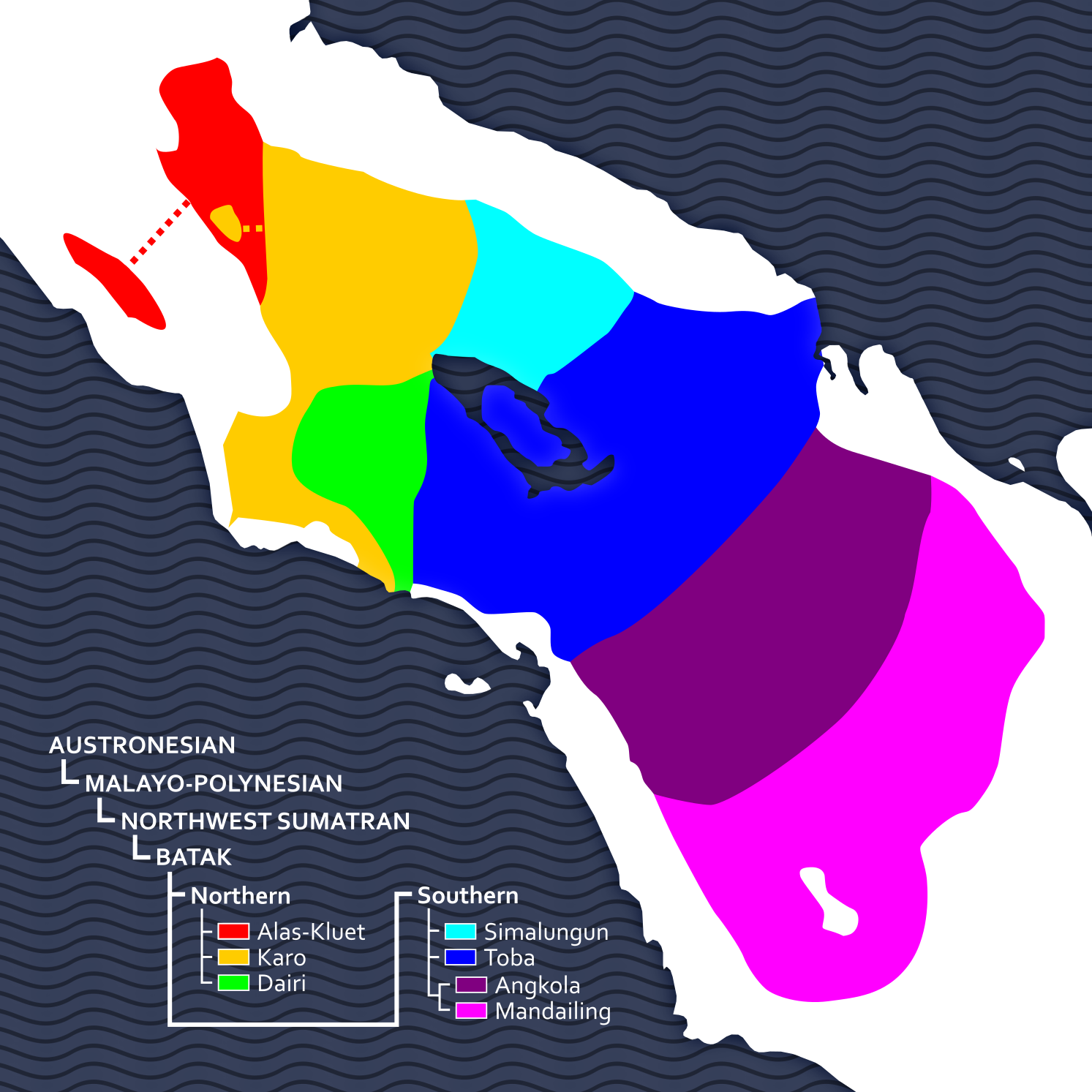|
Batak Alphabet
The Batak script (natively known as ''surat Batak'', ''surat na sampulu sia'' ("the nineteen letters"), or ''si-sia-sia'') is a writing system used to write the Austronesian languages, Austronesian Batak languages spoken by several million people on the Indonesian island of Sumatra. The script may be derived from the Kawi script, Kawi and Pallava script, ultimately derived from the Brahmi script of India, or from the hypothetical Proto-Sumatran script influenced by Pallava. History The Batak magicians and priests or ''datu'' used the Batak script mainly for magical texts and divinatory purposes. It is unknown how many non-specialists were literate in the Batak script, but judging from the widespread tradition of writing love laments, especially among the Karo, Simalungun, and Angkola-Mandailing Batak, it is likely that a considerable part of the non-specialist population was able to read and write the Batak script. After the arrival of Europeans in the Batak lands, first Germ ... [...More Info...] [...Related Items...] OR: [Wikipedia] [Google] [Baidu] |
Abugida
An abugida (, from Ge'ez language, Ge'ez: ), sometimes known as alphasyllabary, neosyllabary or pseudo-alphabet, is a segmental Writing systems#Segmental writing system, writing system in which consonant-vowel sequences are written as units; each unit is based on a consonant letter, and vowel notation is secondary. This contrasts with a full alphabet, in which vowels have status equal to consonants, and with an abjad, in which vowel marking is absent, Abjad#Impure abjads, partial, or optional (although in less formal contexts, all three types of script may be termed alphabets). The terms also contrast them with a syllabary, in which the symbols cannot be split into separate consonants and vowels. Related concepts were introduced independently in 1948 by James Germain Février (using the term ) and David Diringer (using the term ''semisyllabary''), then in 1959 by Fred Householder (introducing the term ''pseudo-alphabet''). The Ethiopian Semitic languages, Ethiopic term "abugi ... [...More Info...] [...Related Items...] OR: [Wikipedia] [Google] [Baidu] |
Batak Ha-1, Ka-1
Batak is a collective term used to identify a number of closely related Austronesian ethnic groups predominantly found in North Sumatra, Indonesia, who speak Batak languages. The term is used to include the Karo, Pakpak, Simalungun, Toba, Angkola, and Mandailing which are related groups with distinct languages and traditional customs (''adat''). Prehistory Linguistic and archaeological evidence indicates that Austronesian speakers first reached Sumatra from Taiwan and the Philippines through Borneo or Java about 2,500 years ago, and the Batak probably descended from these settlers. While the archaeology of southern Sumatra testifies to the existence of neolithic settlers, it seems that the northern part of Sumatra was settled by agriculturalists at a considerably later stage. Although the Batak are often considered to be isolated peoples thanks to their location inland, away from the influence of seafaring European colonials, there is evidence that they have been inv ... [...More Info...] [...Related Items...] OR: [Wikipedia] [Google] [Baidu] |
Batak A-1, Ha
Batak is a collective term used to identify a number of closely related Austronesian peoples, Austronesian ethnic groups predominantly found in North Sumatra, Indonesia, who speak Batak languages. The term is used to include the Karo people (Indonesia), Karo, Pakpak people, Pakpak, Simalungun people, Simalungun, Batak Toba people, Toba, Angkola people, Angkola, and Mandailing people, Mandailing which are related groups with distinct languages and traditional customs (''adat''). Prehistory Linguistic and archaeological evidence indicates that Austronesian peoples, Austronesian speakers first reached Sumatra from Taiwan and the Philippines through Borneo or Java about 2,500 years ago, and the Batak probably descended from these settlers. While the archaeology of southern Sumatra testifies to the existence of neolithic settlers, it seems that the northern part of Sumatra was settled by agriculturalists at a considerably later stage. Although the Batak are often considered to ... [...More Info...] [...Related Items...] OR: [Wikipedia] [Google] [Baidu] |
Toba Batak Language
Toba Batak () is an Austronesian language spoken in North Sumatra province in Indonesia. It is part of a group of languages called Batak. There are approximately 1,610,000 Toba Batak speakers, living to the east, west and south of Lake Toba. Historically it was written using Batak script, but the Latin script is now used for most writing. Nomenclature The name of this language arises from a rich and complex history of ethnic identity in colonial and post-colonial Indonesia. It is a generic name for the common language used by the people of the districts of Toba, Uluan, Humbang, Habinsaran, Samosir, and Silindung, centered upon the Island of Sumatra; more particularly, at Lake Toba. Linguistically and culturally these tribes of people are closely related. Other nearby communities such as Silalahi and Tongging may also be classified as speakers of Toba Batak. The term ''Toba Batak'' is, itself, a derivation of the Toba Batak language. As such, it is used both as a noun a ... [...More Info...] [...Related Items...] OR: [Wikipedia] [Google] [Baidu] |
Simalungun Language
Simalungun, or Batak Simalungun, is an Austronesian language of Sumatra. It is spoken mainly in Simalungun Regency and Pematang Siantar, North Sumatra, Indonesia. References External links Indonesian-Simalungun Dictionary* David Goldsworthy's collection of Music of Indonesia and Malaysia archived with Paradisec The Pacific and Regional Archive for Digital Sources in Endangered Cultures (PARADISEC) is a cross-institutional project that supports work on endangered languages and cultures of the Pacific and the region around Australia. They digitise reel-to ... includes open accesrecordings in Batak Simalungun Batak languages Languages of Indonesia {{au-lang-stub ... [...More Info...] [...Related Items...] OR: [Wikipedia] [Google] [Baidu] |
Pakpak Language
Pakpak, or Batak Dairi, is an Austronesian language of Sumatra. It is spoken in Dairi Regency, Pakpak Bharat Regency, Parlilitan district of Humbang Hasundutan Regency, Manduamas district of Central Tapanuli Regency, and Subulussalam and Aceh Singkil Regency Aceh Singkil Regency ( id, Kabupaten Aceh Singkil) is a regency in the Aceh province of Indonesia. It is situated largely on the island of Sumatra, but also includes the offshore Banyak Islands, the largest of which is Tuangku (Great Banyak), wit .... Phonology Consonants * A word-final /k/ can also be heard as a glottal stop . Vowels * Vowels /i, u, e, o/ can have shortened allophones of , , References Further reading * * * * Batak languages Languages of Indonesia Languages of Aceh {{au-lang-stub ... [...More Info...] [...Related Items...] OR: [Wikipedia] [Google] [Baidu] |
Mandailing Language
Mandailing or Mandailing Batak is an Austronesian language spoken in Indonesia, the northern island of Sumatra. It is spoken mainly in Mandailing Natal Regency, North Padang Lawas Regency, Padang Lawas Regency, and eastern parts of Labuhan Batu Regency, North Labuhan Batu Regency, South Labuhan Batu Regency and northwestern parts of Riau Province. It is written using the Latin script but historically used Batak script. Literature Classical Mandailing literary art is transmitted through a distinctive tradition, for example through the following media: # : Tradition tells the story in a verbal social context. Stories are transmitted from generation to generation. The plot uses advanced themes and a lot of content about manners. # : Differentiated by the theme. is an expression of the heart, a change due to various things, such as the misery of life due to death, abandonment, and others. It also contains knowledge, advice, moral teachings, kinship system, and so on. lamen ... [...More Info...] [...Related Items...] OR: [Wikipedia] [Google] [Baidu] |
Batak Karo Language
Karo, referred to in Indonesia as Bahasa Karo (Karo language), is an Austronesian language that is spoken by the Karo people of Indonesia. It is used by around 600,000 people in North Sumatra. It is mainly spoken in Karo Regency, southern parts of Deli Serdang Regency and northern parts of Dairi Regency, North Sumatra, Indonesia. It was historically written using the Batak alphabet which is descended from the Brahmi script of ancient India by way of the Pallava and Old Kawi scripts, but nowadays only a tiny number of Karo can write or understand the script, and instead the Latin script is used. Classification Karo is a Northern Batak language, and is closely related to Pakpak and Alas. It is mutually unintelligible from the Southern Batak languages, such as Toba, Angkola and Mandailing. Dialects There are several dialects within Karo. A major dialect boundary exists between the dialects spoken in the east and the dialects spoken in the west. These are largely distingu ... [...More Info...] [...Related Items...] OR: [Wikipedia] [Google] [Baidu] |
Diacritic
A diacritic (also diacritical mark, diacritical point, diacritical sign, or accent) is a glyph added to a letter or to a basic glyph. The term derives from the Ancient Greek (, "distinguishing"), from (, "to distinguish"). The word ''diacritic'' is a noun, though it is sometimes used in an attributive sense, whereas ''diacritical'' is only an adjective. Some diacritics, such as the acute ( ◌́ ) and grave ( ◌̀ ), are often called ''accents''. Diacritics may appear above or below a letter or in some other position such as within the letter or between two letters. The main use of diacritics in Latin script is to change the sound-values of the letters to which they are added. Historically, English has used the diaeresis diacritic to indicate the correct pronunciation of ambiguous words, such as "coöperate", without which the letter sequence could be misinterpreted to be pronounced . Other examples are the acute and grave accents, which can indi ... [...More Info...] [...Related Items...] OR: [Wikipedia] [Google] [Baidu] |
Eng (letter)
Eng or engma ( capital: Ŋ, lowercase: ŋ) is a letter of the Latin alphabet, used to represent a voiced velar nasal (as in English ''sii'') in the written form of some languages and in the International Phonetic Alphabet. In Washo, lower-case represents a typical sound, while upper-case represents a voiceless sound. This convention comes from Americanist phonetic notation. History The ''First Grammatical Treatise'', a 12th-century work on the phonology of the Old Icelandic language, uses a single grapheme for the eng sound, shaped like a g with a stroke . Alexander Gill the Elder uses an uppercase G with a hooked tail and a lowercase n with the hooked tail of a script g for the same sound in ''Logonomia Anglica'' in 1619. William Holder uses the letter in ''Elements of Speech: An Essay of Inquiry into the Natural Production of Letters'', published in 1669, but it was not printed as intended; he indicates in his errata that “there was intended a character for Ng, viz., ... [...More Info...] [...Related Items...] OR: [Wikipedia] [Google] [Baidu] |
Brahmi Script
Brahmi (; ; ISO: ''Brāhmī'') is a writing system of ancient South Asia. "Until the late nineteenth century, the script of the Aśokan (non-Kharosthi) inscriptions and its immediate derivatives was referred to by various names such as 'lath' or 'Lat', 'Southern Aśokan', 'Indian Pali', 'Mauryan', and so on. The application to it of the name Brahmi 'sc. lipi'' which stands at the head of the Buddhist and Jaina script lists, was first suggested by T rriende Lacouperie, who noted that in the Chinese Buddhist encyclopedia ''Fa yiian chu lin'' the scripts whose names corresponded to the Brahmi and Kharosthi of the ''Lalitavistara'' are described as written from left to right and from right to left, respectively. He therefore suggested that the name Brahmi should refer to the left-to-right 'Indo-Pali' script of the Aśokan pillar inscriptions, and Kharosthi to the right-to-left 'Bactro-Pali' script of the rock inscriptions from the northwest." that appeared as a fully developed scrip ... [...More Info...] [...Related Items...] OR: [Wikipedia] [Google] [Baidu] |




